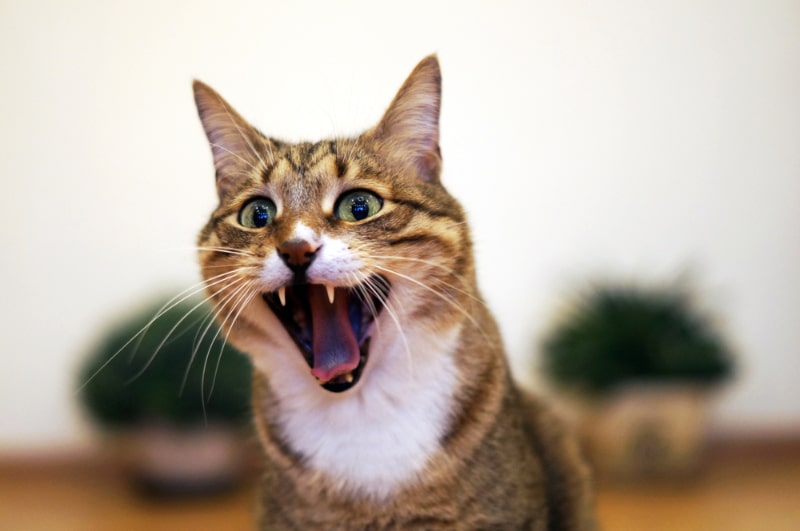
The information is current and up-to-date in accordance with the latest veterinarian research.
Learn more »
Cats make adorable and interesting sounds, but occasionally, they let out yowls that sound just like screams, which is also known as caterwauling or howling. It’s loud, impossible to miss, and usually signals that something is amiss.
Unlike meowing, which adult cats largely reserve for communicating with humans, cats caterwaul to convey information to cats and people, but it’s most often used to get the attention of humans. Howling, screaming, and yowling can be caused by physical conditions, stress, and even hormones. Cats also caterwaul when telling other cats to stay away.
The 6 Reasons that Prompt Cats to Scream
Several situations commonly prompt caterwauling in cats, including when they’re in pain, stressed, experiencing cognitive problems, in need of attention, in heat, or telling another animal to back off.
1. Pain
Cats are experts at hiding signs of illness. It’s frequently difficult to tell when a cat is feeling under the weather, as the signs are often quite subtle. Changes in appetite and behavior are often early signals that something may not be quite right.
Every now and then, when cats are in severe pain, they let out massive yowls, particularly when sensitive parts of their bodies are touched. Cats with painful joints often howl when uncomfortable, and conditions such as kidney and thyroid disease can also cause the behavior.
If your cat has any sudden changes in behavior, including screaming, have them checked out by a veterinarian so whatever is going on can be identified and addressed.
Image Credit: New Africa, Shutterstock
2. Stress
Cats can become stressed when their environment or routine changes. They’re notorious for strongly reacting to environmental alterations, such as the arrival of new pets, visitors, and babies.
Cats are creatures of habit that come to expect cuddles and affection at regular times, like right after breakfast. When household routines suddenly change, cats can become distressed as their go-to times for getting love are no longer accessible.
Other signs of stress include eating less, going to the bathroom in inappropriate places, withdrawal, aggression, and grooming to the point of self-injury. However, these can also be signs of medical conditions, so you should get them examined by your vet.
Exercise is an excellent stress buster, and playing with your cat a few times a day for 10 to 15 minutes can make a massive difference in their well-being by providing fun and mental stimulation. It also releases feel-good hormones that may help mellow cats out by encouraging them to feel safe and secure.
Giving cats places to go where they can get a break from the noise and activity of babies and visitors can keep them mellow. If you’ve recently welcomed a new pet into your home and your cat isn’t responding well, consider separating the animals and giving the introductory process a bit more time. Cat pheromone therapy in a diffuser or spray can also help. These are synthetically made pheromones that mimic the calming feline facial pheromone that cats secrete.
Image Credit: SerPhoto, Shutterstock
3. Cognitive Decline
Cats sometimes suffer from cognitive difficulties when they get older. Common signs of dementia (cognitive dysfunction syndrome) include sleeping during the day and being active at night, not using the litter box, general confusion, anxiety, loss of appetite, problems with grooming, and yowling.
More than 50% of cats over the age of 15 show at least some signs of the condition. Veterinarians aren’t sure what causes some cats to develop dementia, but genetic factors may be at play.
Diagnosing cognitive decline in cats is primarily based on the history provided by pet parents, along with blood tests and other investigations to rule out other conditions that may cause behavioral changes. Dementia can’t be cured, but providing physical and mental stimulation through environmental enrichment, and feeding them high-quality diets full of brain health-enhancing nutrients such as omega-3 fatty acids and antioxidants may help.
Nightlights sometimes help comfort older cats struggling to see in low light conditions, and soft music may help calm anxious pets at night.
Image Credit: athree23, Pixabay
4. Attention
Cats sometimes howl to let their human companions know they want or need something. Some do so when they’re hungry or want to play. Daily play sessions and environmental enrichment can sometimes reduce feline unhappiness (and yowling, as a result).
Ensuring that cats have plenty of toys can keep pets active and be a fun way to give them attention. Making sure they have vertical hangouts and scratchers, establishing routine feeding times, and keeping their litter boxes clean can also reduce the likelihood of screaming.
Image Credit savitskaya iryna, Shutterstock
5. Heat
Female cats often yowl excessively when they’re in heat. It comes along with other behaviors, such as rolling around on the ground, butt wiggling with a raised tail, affectionate behavior, and escape attempts.
Their heat cycles last an average of 2 or 3 weeks, and cats are in active heat for about 7 days on average. Cats that don’t mate during their heat cycle don’t ovulate, and the cycle begins again. Female cats generally go into heat for the first time between 4 and 12 months old.
Spaying cats essentially eliminates the screaming problem, as female cats who’ve undergone the procedure no longer go into heat since their reproductive organs have been removed. Cats can be spayed when they’re as young as 8 weeks old, but the procedure is commonly done when they’re 5 or 6 months old.
Spaying cats before they go into heat for the first time reduces their chance of developing mammary cancer. Spayed cats are also protected from uterine and ovarian cancer and infections.
Image Credit: Maria Sbytova, Shutterstock
6. Territoriality
Cats can be territorial if they feel their space is being infringed upon by a person or animal. They sometimes yowl to let people know it’s time to back off. Birds or squirrels can trigger indoor cats they see outside and neighborhood cats who saunter by or stop to say hello.
Cats in multiple-pet households sometimes become aggressive toward other pets, which can prevent the recipient of the behavior from gaining access to food, toys, and litter boxes. Cats demonstrating territorial aggression often sit straight up and point their ears forward.
Drawing the shades often prevents indoor cats from being stimulated by outdoor temptations. Aggression in multiple-cat households can be reduced by providing several litter boxes and food and water bowls and placing them around the house. Having extra beds and toys on hand can also reduce resource-hoarding behavior. Cats may need to be separated while a vet or behaviorist assesses the cause and recommends an action plan to deal with the problem.
Image Credit: Gerhard G., Pixabay
Conclusion
Caterwauls are hard to miss! Cats caterwaul for various reasons, including when they’re in pain, stressed out, or need something from their owners. It’s also commonly seen when cats are in heat.
Pets experiencing cognitive decline are also prone to yowl out of confusion and distress. Addressing underlying health concerns, stress reduction techniques, and leaving soft music playing to soothe anxious cats at night are just a few ways to improve the situation.
Featured Image Credit: Marina Kapitu, Shutterstock






